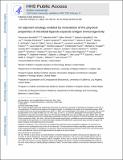| dc.contributor.author | Irvine, Darrell | |
| dc.date.accessioned | 2023-02-23T18:52:53Z | |
| dc.date.available | 2023-02-23T18:52:53Z | |
| dc.date.issued | 2022 | |
| dc.identifier.uri | https://hdl.handle.net/1721.1/148202 | |
| dc.description.abstract | Activation of the innate immune system via pattern recognition receptors (PRRs) is key to generate lasting adaptive immunity. PRRs detect unique chemical patterns associated with invading microorganisms, but whether and how the physical properties of PRR ligands influence the development of the immune response remains unknown. Through the study of fungal mannans, we show that the physical form of PRR ligands dictates the immune response. Soluble mannans are immunosilent in the periphery but elicit a potent pro-inflammatory response in the draining lymph node (dLN). By modulating the physical form of mannans, we developed a formulation that targets both the periphery and the dLN. When combined with viral glycoprotein antigens, this mannan formulation broadens epitope recognition, elicits potent antigen-specific neutralizing antibodies, and confers protection against viral infections of the lung. Thus, the physical properties of microbial ligands determine the outcome of the immune response and can be harnessed for vaccine development. | en_US |
| dc.language.iso | en | |
| dc.publisher | Elsevier BV | en_US |
| dc.relation.isversionof | 10.1016/J.CELL.2022.01.009 | en_US |
| dc.rights | Creative Commons Attribution-NonCommercial-NoDerivs License | en_US |
| dc.rights.uri | http://creativecommons.org/licenses/by-nc-nd/4.0/ | en_US |
| dc.source | PMC | en_US |
| dc.title | An adjuvant strategy enabled by modulation of the physical properties of microbial ligands expands antigen immunogenicity | en_US |
| dc.type | Article | en_US |
| dc.identifier.citation | Irvine, Darrell. 2022. "An adjuvant strategy enabled by modulation of the physical properties of microbial ligands expands antigen immunogenicity." Cell, 185 (4). | |
| dc.contributor.department | Massachusetts Institute of Technology. Department of Biological Engineering | |
| dc.contributor.department | Massachusetts Institute of Technology. Department of Materials Science and Engineering | |
| dc.contributor.department | Koch Institute for Integrative Cancer Research at MIT | |
| dc.contributor.department | Ragon Institute of MGH, MIT and Harvard | |
| dc.contributor.department | Howard Hughes Medical Institute | |
| dc.relation.journal | Cell | en_US |
| dc.eprint.version | Author's final manuscript | en_US |
| dc.type.uri | http://purl.org/eprint/type/JournalArticle | en_US |
| eprint.status | http://purl.org/eprint/status/PeerReviewed | en_US |
| dc.date.updated | 2023-02-23T18:44:53Z | |
| dspace.orderedauthors | Borriello, F; Poli, V; Shrock, E; Spreafico, R; Liu, X; Pishesha, N; Carpenet, C; Chou, J; Di Gioia, M; McGrath, ME; Dillen, CA; Barrett, NA; Lacanfora, L; Franco, ME; Marongiu, L; Iwakura, Y; Pucci, F; Kruppa, MD; Ma, Z; Lowman, DW; Ensley, HE; Nanishi, E; Saito, Y; O’Meara, TR; Seo, H-S; Dhe-Paganon, S; Dowling, DJ; Frieman, M; Elledge, SJ; Levy, O; Irvine, DJ; Ploegh, HL; Williams, DL; Zanoni, I | en_US |
| dspace.date.submission | 2023-02-23T18:45:04Z | |
| mit.journal.volume | 185 | en_US |
| mit.journal.issue | 4 | en_US |
| mit.license | PUBLISHER_CC | |
| mit.metadata.status | Authority Work and Publication Information Needed | en_US |
